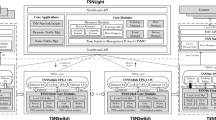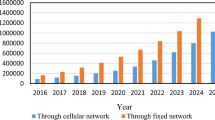Abstract
Asynchronous TDMA bus-link systems using chirp multiplexing transform(CMT) are proposed for radio highway networks to provide the flexibleconstruction of fiber-optic radio access networks and thepossibility of the universal use of these networks among future diverseradio services. The CMT equipped at the radio base station performs twofunctions. One is the conversion of FDM multiple radio services intosignals with a TDMA format and the other is the time compression ofthe generated signal in order to allow asynchronous access. As aresult, the proposed systems can realize the unified transmission ofmultiple radio services and the switching of them in the optical stage(photonic routing) in the networks according to the type of radioservice. The realization of such photonic routing of the radio servicewould greatly benefit the goal of a seamless and universalnetwork available to different types of radio service. Therelationship between the pulse-loss probability performance and thecall-blocking probability performance is theoretically analyzed. Theeffect on the performance of traffic partiality in the coveredarea and the way the performance can be improved are theoreticallyinvestigated. Finally, one of the ways to determine the network sizecovered by a bus link and the number of connected radio base stationsis introduced.
Similar content being viewed by others
References
S. Komaki, K. Tsukamoto, S. Hara and N. Morinaga, “Proposal Fiber and Radio Extension Link for Future Personal Communications”, Microwave and Optical Technology Letters, Vol. 6, No.1, pp. 55–60, 1993.
S. Komaki, K. Tsukamoto, M. Okada and H. Harada, “Proposal of Radio Highway Networks for Future Multimedia-PersonalWireless Communications”, 1994 IEEE International Conference on Personal Wireless Communications (ICPWC 94'), Bangalore India, pp. 204–208, Aug. 1994.
K. Tsukamoto, H. Harada, S. Kajiya, S. Komaki and N. Morinaga, “TDM Intercell Connection Fiber-Optic Bus Link for Personal Radio Communication Systems”, 1994 Asia-Pacific Microwave Conference (APMC'94), Tokyo Japan, pp. 1039–1042, Dec. 1994.
H. Harada, K. Tsukamoto, S. Komaki and N. Morinaga, “Optical TDM Scheme for Fiber-Optic Millimeter-Wave Radio System”, IEICE Trans. Commun., Vol. J77-CI, No.11, pp. 1–10, 1994.
H. Harada, S. Kajiya, K. Tsukamoto, S. Komaki and N. Morinaga, “TDM Intercell Connection Fiber-optic Bus Link for Personal Radio Communication System”, IEICE Trans. Commun., Vol. E78-B, No.9, pp. 1287–1294, 1995.
Y. Shoji, K. Tsukamoto and S. Komaki, “Proposal of the Radio High-Way Networks Using Asynchronous Time Division Multiple Access”, IEICE Trans. Commun., Vol. E79-B, No.3, pp. 308–315, 1996.
Y. Shoji, K. Tsukamoto and S. Komaki, “A Consideration on Radio Highway Networks Using FDM-TDM Conversion Scheme”, International Topical Meeting on Microwave Photonics (MWP'97), pp. 219–222, Sep. 1997.
Y. Shoji, K. Tsukamoto and S. Komaki, “Proposal of Chirp Multiplexing Transform/Intensity Modulation/Direct Detection System for Radio Highway Networks”, IEICE Trans. Fundamentals, Vol. E81-A, No.7, pp. 1396–1405, 1998.
A.J. Mervyn, Peter M. Grand and Jeffrey H. Collins, “The Theory, Design, and Applications of Surface Acoustic Wave Fourier-Transform Processors”, Proceeding of the IEEE, Vol. 68, No.4, pp. 450–468, 1980.
Y.E. Kai and O. Yue, “Time Compression Multiplexing of Multiple Television Signals in Satellite Channels Using Chirp Transform Processors”, IEE Trans. Commun., Vol. COM-29, No.12, pp. 1832–1840, 1981.
T. Kohri, M. Morikura and S. Kato, “Non-Regenerative Onboard FDM/TDM Transmultiplexer”, IEICE Trans., Vol. J69-B, No.11, pp. 1480–1487, 1986.
K. Kobayashi, T. Kumagai and S. Kato, “A Group Demodulator Employing Multi-Symbol Chirp Fourier Transform”, IEICE Trans. Commun., Vol. E77-B, No.7, pp. 905–910, 1994.
T. Kumagai and K. Kobayashi, “A New Group Demodulator with Multi-Symbol Chirp Fourier Transform for Mobile Communication Systems”, Proceeding of IEEE ICUPC'95, pp. 397–401, Nov. 1995.
R. Ganesh and K. Joseph, “Effect of Non-Uniform Traffic Distributions on Performance of a Cellular System”, 1996 IEEE 6th International Conference on Universal Personal Communications Record (ICUPC'97), Vol. 2, pp. 598–602, 1996.
H. Taub and D.L. Schilling, “Principles of Communication Systems,” McGraw-Hill International Editions, Electrical and Electronic Engineering Series, 1986.
Author information
Authors and Affiliations
Rights and permissions
About this article
Cite this article
Shoji, Y., Hida, T., Tsukamoto, K. et al. Proposal of Asynchronous Time Division Multiple Access Radio Highway Using Chirp Multiplexing Transform. Wireless Personal Communications 14, 183–197 (2000). https://doi.org/10.1023/A:1008990720961
Issue Date:
DOI: https://doi.org/10.1023/A:1008990720961




